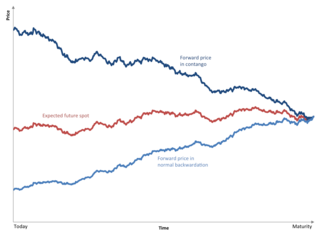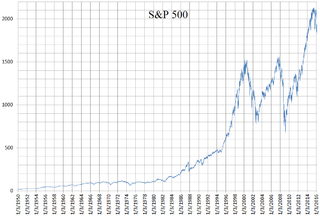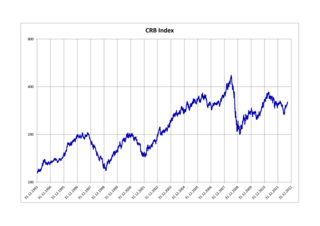Related Research Articles

A commodity market is a market that trades in the primary economic sector rather than manufactured products, such as cocoa, fruit and sugar. Hard commodities are mined, such as gold and oil. Futures contracts are the oldest way of investing in commodities. Commodity markets can include physical trading and derivatives trading using spot prices, forwards, futures, and options on futures. Farmers have used a simple form of derivative trading in the commodity market for centuries for price risk management.

Contango is a situation where the futures price of a commodity is higher than the expected spot price of the contract at maturity. In a contango situation, arbitrageurs or speculators are "willing to pay more [now] for a commodity [to be received] at some point in the future than the actual expected price of the commodity [at that future point]. This may be due to people's desire to pay a premium to have the commodity in the future rather than paying the costs of storage and carry costs of buying the commodity today." On the other side of the trade, hedgers are happy to sell futures contracts and accept the higher-than-expected returns. A contango market is also known as a normal market, or carrying-cost market.

The Standard and Poor's 500, or simply the S&P 500, is a stock market index tracking the stock performance of 500 of the largest companies listed on stock exchanges in the United States. It is one of the most commonly followed equity indices and includes approximately 80% of the total market capitalization of U.S. public companies, with an aggregate market cap of more than $43 trillion as of January 2024.

The Goldman Sachs Group, Inc. is an American multinational investment bank and financial services company. Founded in 1869, Goldman Sachs is headquartered in Lower Manhattan in New York City, with regional headquarters in many international financial centers. Goldman Sachs is the second largest investment bank in the world by revenue and is ranked 55th on the Fortune 500 list of the largest United States corporations by total revenue. In Forbes Global 2000 2023, Goldman Sachs ranked 34th. It is considered a systemically important financial institution by the Financial Stability Board.
The Standard & Poor's Commodity Index (SPCI) is a commodity price index that measures the price changes in a cross section of agricultural and industrial commodities with actively traded U.S. futures contracts, stretching across five sectors - Energy, Metals, Grains, Livestock, and Fibers & Softs. Only commodities that are consumed for industrial use are included in the index. Weights in the index are determined by the dollar value of Commercial Open Interest (COI) for each component commodity, and rebalanced annually each February.
The S&P GSCI serves as a benchmark for investment in the commodity markets and as a measure of commodity performance over time. It is a tradable index that is readily available to market participants of the Chicago Mercantile Exchange. The index was originally developed in 1991, by Goldman Sachs. In 2007, ownership transferred to Standard & Poor's, who currently own and publish it. Futures of the S&P GSCI use a multiple of 250. The index contains a much higher exposure to energy than other commodity price indices such as the Bloomberg Commodity Index.
The Bloomberg Commodity Index (BCOM) is a broadly diversified commodity price index distributed by Bloomberg Index Services Limited. The index was originally launched in 1998 as the Dow Jones-AIG Commodity Index (DJ-AIGCI) and renamed to Dow Jones-UBS Commodity Index (DJ-UBSCI) in 2009, when UBS acquired the index from AIG. On July 1, 2014, the index was rebranded under its current name.

The FTSE/CoreCommodity CRB Index is a commodity futures price index. It was first calculated by Commodity Research Bureau, Inc. in 1957 and made its inaugural appearance in the 1958 CRB Commodity Year Book.

CME Group Inc. is a financial services company. Headquartered in Chicago, the company operates financial derivatives exchanges including the Chicago Mercantile Exchange, Chicago Board of Trade, New York Mercantile Exchange, and The Commodity Exchange. The company also owns 27% of S&P Dow Jones Indices. It is the world's largest operator of financial derivatives exchanges. Its exchanges are platforms for trading in agricultural products, currencies, energy, interest rates, metals, futures contracts, options, stock indexes, and cryptocurrencies futures.
The Deutsche Bank Liquid Commodity Index (DBLCI) is a commodity price index operated by German based Deutsche Bank. It was launched in February 2003 and tracks the performance of six commodities in the energy, precious metals, industrial metals and grain sectors. The DBLCI has constant weightings for each of the six commodities and the index is rebalanced annually in the first week of November. Consequently, the weights fluctuate during the year according to the price movement of the underlying commodity futures.
DBLCI Optimum Yield Index (DBLCI-OY) is a commodity price index operated by German Deutsche Bank. It is similar to the Deutsche Bank Liquid Commodity Index but has more commodities from more sectors. The DBLCI-OY indices are available for 24 commodities drawn from the energy, precious metals, industrial metals, agricultural and livestock sectors. A DBLCI-OY index based on the DBLCI benchmark weights is also available and the optimum yield technology has also been applied to the energy, precious metals, industrial metals and agricultural sector indices.
DBLCI optimum yield balanced index (DBLCI-OY) is a commodity price index operated by German based Deutsche Bank that is based on the Deutsche Bank Liquid Commodity Index but with reduced energy sector weighting. The DBLCI-OY Balanced has the same underlying 14 commodities as the DBLCI-OY Broad, but, the energy sector weight is reduced from 55% of the broad index to 35%. The DBLCI-OY Balanced is designed to be UCITS III compliant, that is the weight of no single commodity or strongly correlated securities exceed 35%. The DBLCI-OY Balanced is listed as an Exchange-traded fund (ETF) on the Deutsche Börse.

S&P Dow Jones Indices LLC is a joint venture between S&P Global, the CME Group, and News Corp that was announced in 2011 and later launched in 2012. It produces, maintains, licenses, and markets stock market indices as benchmarks and as the basis of investable products, such as exchange-traded funds (ETFs), mutual funds, and structured products. The company currently has employees in 15 cities worldwide, including New York, London, Frankfurt, Singapore, Hong Kong, Sydney, Beijing, and Dubai.
AIG Financial Products Corporation (AIGFP) is a subsidiary of the American International Group, headquartered in New York, New York, with major operations in London. The collapse of AIG Financial Products, headquartered in Wilton, Connecticut, is considered to have played a pivotal role in the global financial crisis of 2008–2009.

In finance, a stock index, or stock market index, is an index that measures the performance of a stock market, or of a subset of a stock market. It helps investors compare current stock price levels with past prices to calculate market performance.
A commodity index fund is a fund whose assets are invested in financial instruments based on or linked to a commodity price index. In just about every case the index is in fact a commodity futures index.
The Goldman roll is the monthly sale and purchase of commodities for the Goldman Sachs Commodity Index (S&P-GSCI).

Goldman Sachs, an investment bank, has been the subject of controversies. The company has been criticized for lack of ethical standards, working with dictatorial regimes, close relationships with the U.S. federal government via a "revolving door" of former employees, and driving up prices of commodities through futures speculation. It has also been criticized by its employees for 100-hour work weeks, high levels of employee dissatisfaction among first-year analysts, abusive treatment by superiors, a lack of mental health resources, and extremely high levels of stress in the workplace leading to physical discomfort.
LME Aluminium stands for a group of spot, forward, and futures contracts, trading on the London Metal Exchange (LME), for delivery of primary Aluminium that can be used for price hedging, physical delivery of sales or purchases, investment, and speculation. Producers, semi-fabricators, consumers, recyclers, and merchants can use Aluminium futures contracts to hedge Aluminium price risks and to reference prices. Notable companies that use LME Aluminium contracts to hedge Aluminium prices include General Motors, Boeing, and Alcoa.
LME Zinc stands for a group of spot, forward, and futures contracts traded on the London Metal Exchange (LME), for delivery of special high-grade Zinc with a 99.995% purity minimum that can be used for price hedging, physical delivery of sales or purchases, investment, and speculation. Producers, semi-fabricators, consumers, recyclers, and merchants can use Zinc futures contracts to hedge Zinc price risks and to reference prices.